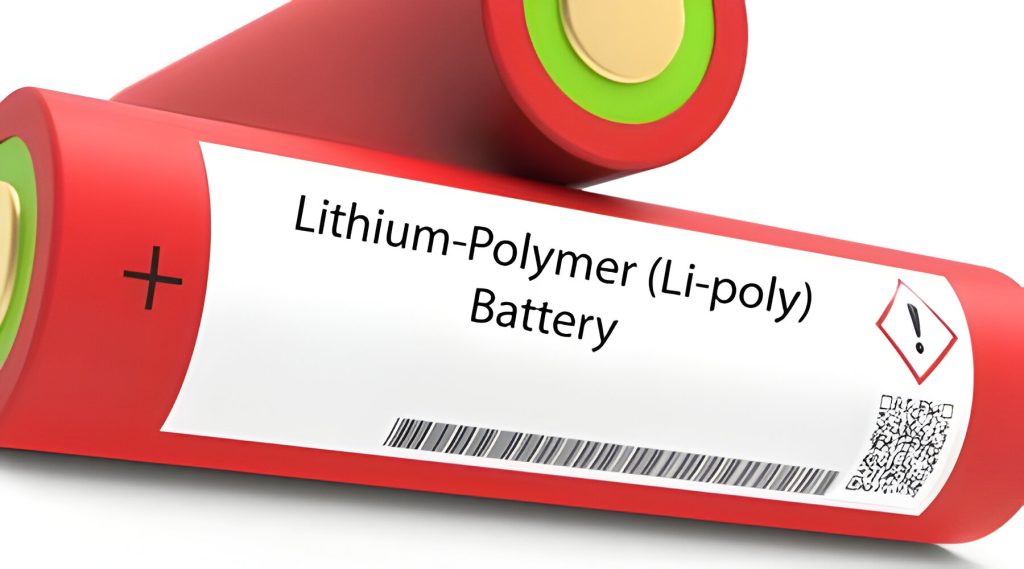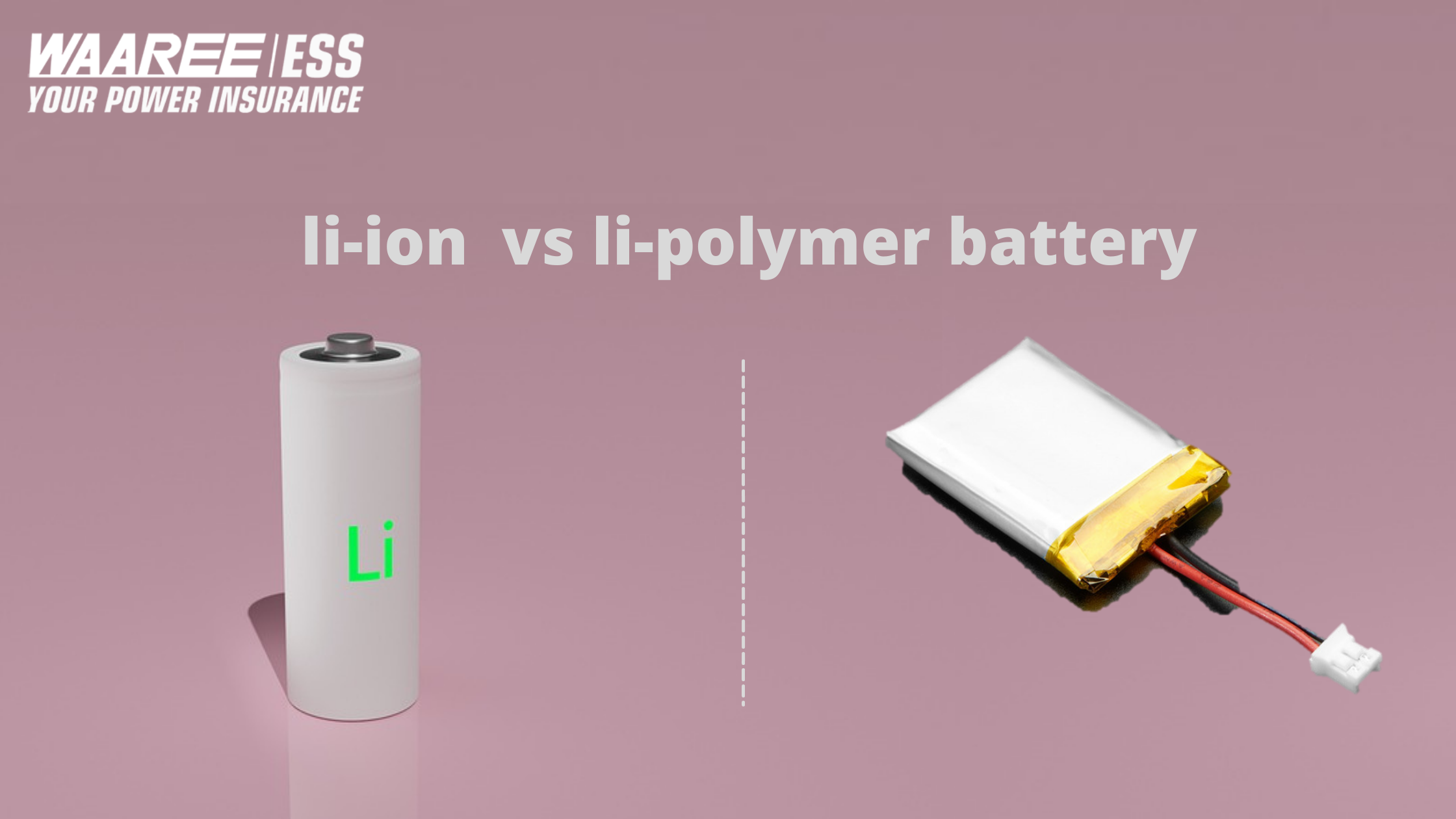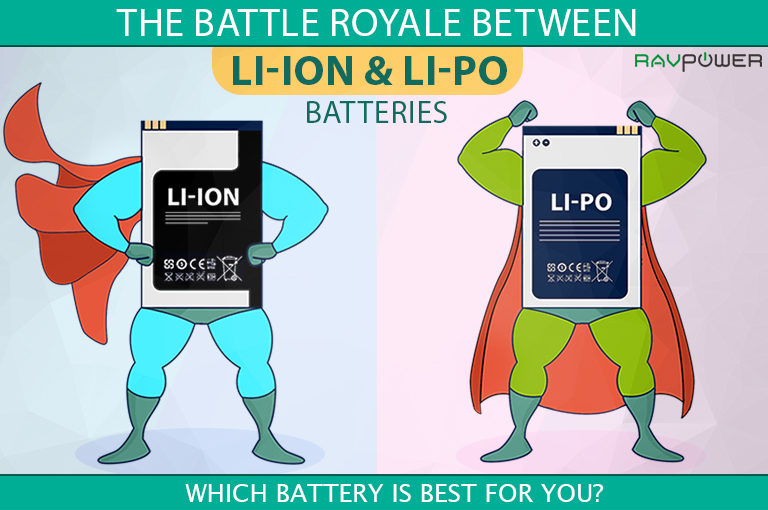Li-polymer batteries offer a flexible, lightweight form factor, while lithium-ion batteries are known for higher energy density and longer lifespans. Choosing between them depends on the specific application needs.
Exploring the differences between Li-polymer and lithium-ion batteries is crucial for consumers and manufacturers alike. Li-polymer, short for lithium polymer, is a type of battery that stands out for its thin, light design and the potential for custom shapes, making it ideal for wearable technology and modern smartphones.
On the other hand, lithium-ion batteries are widely used in laptops, electric vehicles, and various portable devices due to their higher capacity and efficiency. Each type presents unique advantages, like the low self-discharge rate of lithium-ion batteries or the improved safety features of Li-polymer options. As technology advances, understanding these nuances becomes essential in selecting the correct battery for your device.

Credit: blog.ravpower.com
Li Polymer Battery Vs Lithium Ion Battery
Lithium Polymer (Li-Poly) and Lithium-Ion (Li-Ion) batteries are two popular rechargeable batteries used in electronic devices, each with unique advantages. Li-Ion batteries are known for their high energy density and long life cycles, making them popular for smartphones, laptops, and electric vehicles. They typically come in cylindrical or rectangular shapes. On the other hand, Li-Poly batteries are more flexible in terms of form factor, allowing them to be made in ultra-thin and custom shapes,
which suits wearable devices and mobile phones that require sleek designs. Li-Poly batteries also tend to have a lower chance of leaking electrolytes compared to Li-Ion batteries, making them perceived as safer. However, they usually have a lower energy density and can be more costly to manufacture. Both technologies continue to evolve, each finding their preferred applications based on device design requirements, power capacity, and cost considerations.
Introduction To Li Polymer And Lithium Ion Batteries
Introduction to Li Polymer and Lithium Ion Batteries
Batteries power our world, from smartphones to laptops. Two types are Li-Polymer (LiPo) and Lithium Ion (Li-Ion). These batteries have changed how we use devices. LiPo is known for its lightweight and flexibility. Li-Ion is famous for its high energy density. Each type has unique benefits.
The Rise Of Rechargeable Batteries
Rechargeable batteries have become essential. Nearly all of our devices have them. They last longer than single-use batteries, and they reduce waste, helping our planet.
- Long life: Charge them many times.
- Cost-effective: Save money over time.
- Eco-friendly: Fewer batteries in landfills.
Key Players: Li-Polymer And Li-ion
Li-Polymer and Li-Ion batteries lead the charge. Each has its strengths. Li-Polymer is slim and moldable, while Li-Ion holds more power.
| Feature | Li-Polymer | Li-Ion |
|---|---|---|
| Weight | Lighter | Heavier |
| Flexibility | More flexible | Less flexible |
| Energy Density | Lower | Higher |

Historical Evolution
Understanding the evolution of battery technology is crucial. It offers insights into today’s advancements. The journey from lithium-ion to lithium polymer batteries marks a significant leap. This leap enhances how we power our devices.
The Advent Of Lithium Batteries
Lithium batteries first emerged in the 1970s. They transformed the landscape of portable power. Lighter and offering higher energy densities, they quickly became the standard for electronics. Their rechargeable version, lithium-ion, arrived in the 1990s. It brought even more power and rechargeability to the table.
- Lithium batteries: Debuted for commercial use in the 1970s
- Higher energy density: Enabled longer-lasting portable devices
- Lithium-ion batteries: Introduced in the 1990s, allowed recharging
The Development Of Polymer Technology
At the turn of the century, polymer technology began to rise. Lithium polymer batteries, or LiPo, use a polymer electrolyte, making them lighter, more flexible, safer, and more stable. This technology continues to evolve, making gadgets like smartphones and drones more efficient.
| Feature | Lithium-ion | Lithium Polymer |
|---|---|---|
| Electrolyte Type | Liquid | Polymer |
| Flexibility | Rigid | Flexible |
| Stability | Good | Better |
| Weight | Heavier | Lighter |
LiPo batteries have brought a new era. They are preferred for cutting-edge applications, and their unique properties make them ideal for modern needs.
Chemical Foundations
Chemical Foundations play a pivotal role in battery performance. Understanding the chemistry behind batteries is critical. It helps us choose the right type for our devices. Let’s delve into the mechanisms that power Lithium Ion and Lithium Polymer batteries.
The Lithium Ion Mechanism
Lithium-ion batteries depend on the movement of lithium ions. These ions move between two electrodes, the anode and the cathode. During charging, lithium ions move to the anode. When discharging, they travel back to the cathode.
- Anode: Made from carbon, usually graphite.
- Cathode: Made from lithium metal oxide.
- Electrolyte: A lithium salt in an organic solvent.
This flow creates an electric current, which powers our devices. The chemistry offers high energy density, translating to more power in a condensed area.
Li-Polymer: A Different Approach
Li-Polymer batteries use a different chemistry. They have a solid polymer electrolyte. This polymer can be a dry solid, a porous film, or a gel.
| Component | Description |
|---|---|
| Electrolyte | A polymer conducts lithium ions. |
| Electrodes | Similar to Lithium Ion, but may be laminated to the polymer. |
This design allows for thin, flexible batteries. They mold into different shapes. This is great for smartphones and wearable devices.
Li-polymer batteries are lightweight, safer, and less likely to leak electrolytes.

Credit: waareeess.com
Energy Density Showdown
Welcome to the Energy Density Showdown between Li-Polymer and Lithium Ion batteries. This comparison reveals which battery type tops the charts regarding capacity and impact on battery life.
Comparing Capacity
Regarding energy density, we refer to how much power a battery can hold. Let’s break it down:
- Lithium Ion batteries often have a higher energy density. This means they can power your devices longer on a single charge.
- While slightly lower in energy density, Li-polymer batteries are more flexible in size and shape, allowing for innovative device designs.
| Battery Type | Energy Density (Wh/L) |
|---|---|
| Lithium Ion | 250-693 |
| Li-Polymer | 300-730 |
Impact On Battery Life
The energy density also impacts how long the battery lasts before it needs replacing:
- Lithium Ion batteries typically offer around 500-1000 charge cycles.
- Li-Polymer batteries can deliver about 300-500 charge cycles.
This means Lithium Ion batteries often last longer. They provide more total energy over their lifetime.
Physical Flexibility And Design
Physical flexibility and design are crucial when choosing a battery for your device. These factors determine how well a battery fits into the increasingly slim and custom-shaped modern gadgets. In this aspect, let’s delve into the differences between Li-Polymer and Lithium Ion batteries.
Li Polymer’s Versatility
Li-Polymer batteries stand out for their adaptability. They are lightweight and moldable, allowing designers to create batteries in various shapes and sizes. Such freedom is essential for innovative device designs.
- Flexible form factors
- Thin and light profiles
- Custom shapes for unique devices
Manufacturers can create ultra-thin batteries that are as thin as one millimeter. This makes Li-Polymer batteries ideal for modern, sleek gadgets.
Lithium Ion’s Rigidity
In contrast, Lithium Ion batteries are more rigid. Usually, they have prismatic or cylindrical forms. While reliable, they offer less flexibility for innovative design.
| Lithium Ion Battery | Characteristics |
|---|---|
| Shape | Cylindrical or Prismatic |
| Flexibility | Low |
| Design Innovation | Limited |
Despite their limitations, Lithium-Ion batteries are well-established and commonly used. They are a trusted power source for many electronic devices.
Safety And Stability Considerations
Safety and Stability Considerations are crucial when comparing Li-Polymer (LiPo) and Lithium Ion (Li-ion) batteries. Both types power countless devices, yet they differ in handling stress and potential risks. Let’s examine how each battery responds to overheating and physical damage.
Risk Of Overheating
Li-ion and LiPo batteries both come with overheating concerns. Smart electronics use them for energy. Heat can build up during use or charging. This heat can lead to problems.
- Li-ion batteries can overheat if damaged or overcharged. An explosion or fire may result from this. LiPo batteries are more stable and have a lower risk of overheating, but they are not immune to heat-related issues.
Both battery types include safety mechanisms. These mechanisms stop charging if they detect too much heat.
Tolerance To Damage
Batteries can get damaged from falls or impacts. This damage can affect safety and performance.
| Battery Type | Damage Tolerance |
|---|---|
| Li-ion | Less flexible, more prone to damage from impacts |
| LiPo | More flexible, better at handling physical stress |
Li-ion batteries have a rigid structure, making them vulnerable to physical damage. On the other hand, LiPo batteries are flexible and can take more hits without significant issues.
Cost And Availability
Cost and availability are key factors when choosing batteries. Let’s compare Li-Polymer and Lithium-Ion batteries.
Production Expenses
Li-Polymer batteries are pricier to make than Lithium Ion batteries.
This is because their production needs more advanced technology and materials.
Lithium Ion batteries are cheaper due to their straightforward build and established manufacturing processes.
Market Accessibility
Lithium Ion batteries dominate the market. They are found in many devices.
Li-Polymer batteries are less standard but growing in popularity for specific uses.
- Phones and laptops often use Li-Polymer for their sleek designs.
- Electric vehicles and power tools mostly use lithium ions.

Credit: m.youtube.com
Environmental Impact
The world is moving towards sustainable solutions. Batteries power our lives but also affect our planet. Let’s compare Li-Polymer and Lithium Ion batteries. We will focus on their disposal, recycling, and carbon footprint.
Disposal And Recycling
Safe disposal is critical for any battery. Both Li-Polymer and Lithium Ion batteries contain harmful chemicals, which must not reach the environment. Special facilities handle their disposal. Recycling helps recover valuable materials. It reduces the need to extract more raw materials, reducing waste and environmental harm. Yet, recycling rates for these batteries remain low. We need better systems and awareness.
- Li-Polymer Battery: Harder to recycle due to its flexible form.
- Lithium Ion Battery: Better recycling processes available.
Carbon Footprint Comparison
The carbon footprint measures environmental impact and shows the total greenhouse gases produced. We consider the batteries’ entire life cycle, including production, use, and disposal.
| Battery Type | Carbon Footprint |
|---|---|
| Li-Polymer Battery | Lower manufacturing emissions |
| Lithium Ion Battery | Higher due to intensive production |
Both batteries have pros and cons. Choosing the right battery can lower your carbon footprint, which affects our planet’s future. It’s essential to consider the environmental impact of your battery.
Industry Applications
Exploring batteries ‘Industry Applications’ reveals a competitive edge between Li-Polymer and Lithium Ion technologies. Each has unique strengths tailored for specific uses.
Consumer Electronics
Li-Polymer batteries shine in personal devices. Their flexible shape allows for sleek smartphone designs. Here’s why:
- Lightweight: Ideal for portable gadgets.
- Customizable: Fits various shapes and sizes.
- Safe: Less prone to leakage than Lithium Ion.
In contrast, Lithium Ion batteries power laptops and cameras. They offer:
- High energy density: Longer use between charges.
- Quick charging: Saves time for users.
- Cost-effective: Provides value for manufacturers.
Electric Vehicles And Beyond
The EV market favors Lithium Ion batteries for them:
- High capacity: Travels further on a single charge.
- Longevity: Sustains more charge cycles.
- Power output: Delivers consistent performance.
Li-Polymer batteries, while less common, offer:
- Lightness: Reduces overall vehicle weight.
- Flexibility: Adapts to innovative car designs.
- Potential: Emerging tech might change the game.
Future Prospects
As technology races forward, the battery industry faces a pivotal moment. The quest for more efficient, long-lasting batteries is on. Li-polymer and Lithium-Ion batteries are at the forefront of this revolution. Let’s explore the prospects of these power sources.
Technological Advancements
Current research focuses on enhancing battery performance. Scientists aim to improve energy density and reduce charging times. Innovations include:
- Solid-state batteries: Offer more excellent safety and potential for higher capacity.
- Silicon anodes: Increase capacity compared to traditional graphite.
- Advanced electrolytes: Improve ion flow and reduce degradation.
Such advancements promise to make batteries safer and more environmentally friendly.
The Next Generation Of Batteries
The race to build the ultimate battery is on. The next generation aims to address current limitations. Key features include:
| Feature | Li-Polymer Battery | Lithium Ion Battery |
|---|---|---|
| Flexibility | More adaptable to different shapes | More rigid in form |
| Energy Density | Improvements underway | Higher but reaching limits |
| Sustainability | Focus on eco-friendly materials | Recycling processes improving |
Emerging technologies, such as graphene batteries, may soon outshine current options. They offer incredible charge speeds and expanded lifespans.

Frequently Asked Questions
Which Is Better Lithium-ion Battery Or Lithium Polymer Battery?
Lithium-ion batteries offer higher energy density, while lithium polymer batteries are more robust and flexible and have a lower chance of leakage. Your choice depends on device requirements and personal preference.
Can I Replace Lithium-ion Battery With Lithium Polymer?
Yes, you can replace a lithium-ion battery with a lithium polymer battery if the voltage and connector type match and the device has space to accommodate it. Always consult your device’s specifications or a professional to ensure compatibility and safety.
Do Lithium-polymer Batteries Last Long?
Lithium-polymer batteries typically offer long lifespans, with many lasting 3-5 years or 500-1000 charge cycles, whichever comes first.
How Do You Tell If A Battery Is Lithium Ion Or Polymer?
Check the battery’s label for its type. Lithium-ion batteries typically mention “Li-ion,” while polymer batteries say “Li-po” or “Lithium Polymer. “Furthermore, polymer batteries typically have a softer, pouch-like shell and weigh less.
Conclusion
Choosing between Li-polymer and lithium-ion batteries depends on your specific needs. Li-polymer offers flexibility and lightweight benefits, making it ideal for modern, slim devices. Meanwhile, lithium-ion provides longer life and higher energy density, making it suited for intensive use. Consider your priorities when selecting the best battery technology for your application.


